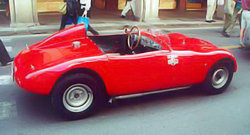Difference between revisions of "Stanga"
m |
m |
||
| Line 3: | Line 3: | ||
| − | The Stanga family (the three brothers were Gianfranco, Sandro and Camillo) was another constructor of small competition cars in the early 1950's. For the 1949 Mille Miglia they prepared a car for themselves using Fiat 500 mechanicals with a Siata cylinder-head. Finishing that race they were motivated to improve their mount for the following year, which comprised a tubular chassis from Gilco, a body by Motto, a Giannini engine and a Siata cylinder-head. | + | The '''Stanga''' family (the three brothers were Gianfranco, Sandro and Camillo) was another constructor of small competition cars in the early 1950's. For the 1949 Mille Miglia they prepared a car for themselves using Fiat 500 mechanicals with a Siata cylinder-head. Finishing that race they were motivated to improve their mount for the following year, which comprised a tubular chassis from Gilco, a body by Motto, a Giannini engine and a Siata cylinder-head. |
[[Image:Stanga soon got on the barchetta bandwagon with this 750 sports racer. The Stanga family still participate with their vintage cars in many Italian events.jpg|thumb|right|300px|'''Stanga soon got on the barchetta bandwagon with this 750 sports racer. The Stanga family still participate with their vintage cars in many Italian events.<br> | [[Image:Stanga soon got on the barchetta bandwagon with this 750 sports racer. The Stanga family still participate with their vintage cars in many Italian events.jpg|thumb|right|300px|'''Stanga soon got on the barchetta bandwagon with this 750 sports racer. The Stanga family still participate with their vintage cars in many Italian events.<br> | ||
Revision as of 15:44, 6 February 2009
The Stanga family (the three brothers were Gianfranco, Sandro and Camillo) was another constructor of small competition cars in the early 1950's. For the 1949 Mille Miglia they prepared a car for themselves using Fiat 500 mechanicals with a Siata cylinder-head. Finishing that race they were motivated to improve their mount for the following year, which comprised a tubular chassis from Gilco, a body by Motto, a Giannini engine and a Siata cylinder-head.
More from Velocetoday.com
A small number of similar cars were built, generally using the formula of a tubular chassis with a dohc Giannini engine, although the last car they built used the mechanicals from the Fiat 600. Although most of their cars were open two-seaters a few coupés were also built, with the bodies generally by Motto.
The last car they constructed emerged in 1956 after which the brothers went on to compete in other vehicles.
